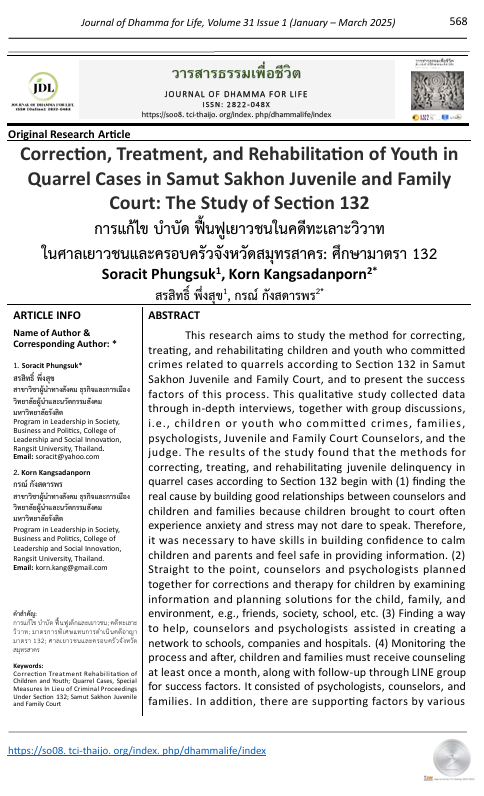Correction, Treatment, and Rehabilitation of Youth in Quarrel Cases in Samut Sakhon Juvenile and Family Court: The Study of Section 132
Main Article Content
Abstract
This research aims to study the method for correcting, treating, and rehabilitating children and youth who committed crimes related to quarrels according to Section 132 in Samut Sakhon Juvenile and Family Court, and to present the success factors of this process. This qualitative study collected data through in-depth interviews, together with group discussions, i.e., children or youth who committed crimes, families, psychologists, Juvenile and Family Court Counselors, and the judge. The results of the study found that the methods for correcting, treating, and rehabilitating juvenile delinquency in quarrel cases according to Section 132 begin with (1) finding the real cause by building good relationships between counselors and children and families because children brought to court often experience anxiety and stress may not dare to speak. Therefore, it was necessary to have skills in building confidence to calm children and parents and feel safe in providing information. (2) Straight to the point, counselors and psychologists planned together for corrections and therapy for children by examining information and planning solutions for the child, family, and environment, e.g., friends, society, school, etc. (3) Finding a way to help, counselors and psychologists assisted in creating a network to schools, companies and hospitals. (4) Monitoring the process and after, children and families must receive counseling at least once a month, along with follow-up through LINE group for success factors. It consisted of psychologists, counselors, and families. In addition, there are supporting factors by various programs of the Juvenile and Family Court as well as networks of educational institutions, private organizations, and community leaders where children and families live. The LINE application also had an important role as a tool for communicating behavior change, including being a channel for quick and flexible advice. Suggestions for the government sector, especially organizations related to the family institution, included: urgently promoting and providing knowledge on raising children and teenagers to families; and proposing the continuation of research to create knowledge in correction, treatment, and rehabilitation for children and youth in various offenses.


